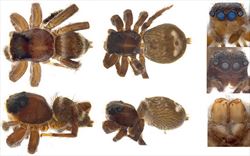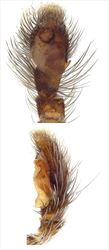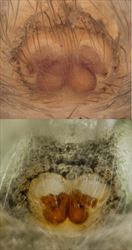
Example of live Saitis
Illustrators (and ©) I.R. Macaulay (TL, ML), G. Anderson (B), R. Whyte (RM), A. Parsons (TR)

Aspects of the general morphology of Saitis
Illustrator (and ©) B.J. Richardson (CSIRO)

Palp morphology of Saitis
Illustrator (and ©) B.J. Richardson (CSIRO)

Epigyne morphology of Saitis
Illustrator (and ©) B.J. Richardson (CSIRO)
Saitis Simon, 1876
Taxonomy
The old world genus, Saitis, presently includes twenty-four species world-wide. Australia has eight species: Saitis insectus, S. insulanus, S. lacustris, S. magniceps, S. mutans, S. signatus, S. taeniatus and S. virgatus, however several of the placements are problematic. Some of the Australian species are part of a closely related set of Australian genera (Barraina, Hypoblemum, Jotus, Maratus, Prostheclina and Saratus) (Otto and Hill, 2012, Zhang and Maddison, 2015). Further information on the genus and described species can be found in Otto and Hill, (2012), Richardson and Żabka (2017) and Whyte and Anderson (2017).
Description
Australian species in Saitis are mostly small to medium-sized spiders, ranging in body length from 3 to 6 mm. The head, viewed from above, is rectangular to pear-shaped, widest behind the posterior lateral eyes. The carapace is high, highest at the posterior lateral eyes. The abdomen is heart-shaped or ovate. Chelicerae have one unident retromarginal tooth and two promarginal teeth. The fourth pair of legs is longest in the females with the third pair strongly fringed and longer or about equal to the fourth pair in the males. The first pair of legs is stronger than the others, with strong spines on the tibia and metatarsus.
The male’s palp has a strongly-built coiled embolus forming an anticlockwise circle in the distal third of the tegulum, accompanied closely by a separate sclerite. The tegulum is ovate with a large proximal lobe. The tibia of the palp has a single, pointed, apophysis of medium length.
The female has two, large, poorly-sclerotised epigynal atria. The copulatory openings are located a little more than half-way, laterally, along the inside margin of the atria. Wide to bulbous insemination ducts travel medially to the anterior margins of the spermathecae which are rounded to pear-shaped, near the epigastric fold but not past the lower margin of the atria.
Biology
In Australia, Saitis has been found in inland to coastal environments in woodland and open forest.
Distribution
Saitis has been collected in central and eastern Australia and from Lord Howe and Norfolk Islands.
References
Otto, J.C. & Hill, D.E. 2012. Notes on Maratus Karsch 1878 and related jumping spiders from Australia, with five new species (Araneae: Salticidae: Euophryinae). Peckhamia 103.1, 1-81
Richardson, B.J. & Żabka, M. 2017. Salticidae. Arachnida: Araneomorphae. Canberra, Australian Faunal Directory. Australian Biological Resources Study, at https://biodiversity.org.au/afd/taxa/SALTICIDAE.
Zhang, Junxia & Maddison, W.P. 2015. Genera of euophryine jumping spiders (Araneae: Salticidae), with a combined molecular-morphological phylogeny. Zootaxa 3938: 1-147.
Whyte, R. & Anderson, G. 2017. A Field Guide to Spiders of Australia. CSIRO Publishing: Clayton.
* The information sheet should be read in the context of the associated diagrams and photographs. Diagrams explaining anatomical terms can be found in the ‘Salticidae’ pictures at the beginning of the list of genera.